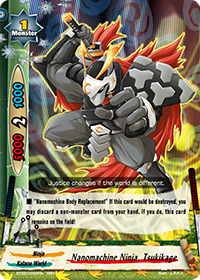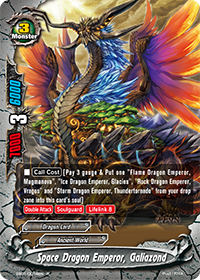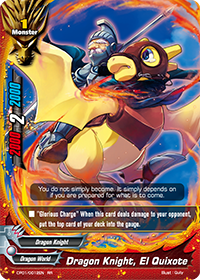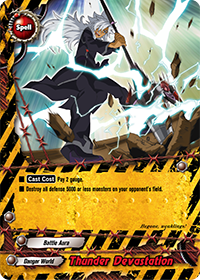 |
| If you can't think and do basic math, get out. |
Remember the card advantage article I published a while back? Let's start applying what that means to strategies. Cards on the field are worth the same as cards in the hand, and both are equated to about 2 damage. So instead of dealing 2 damage to your opponent, you could simply get rid of one of his monsters; the advantage gained is the same. Obviously if you have a card that has only 1 crit and are given the option to either kill a monster or deal damage, the correct advantageous choice should be obvious.
 |
| Unkillable |
Eh, but there's more. How did we equate cards to damage again? Right, not through the cards themselves, but the attacks. Specifically, one attack is equal to 2 damage on average. If you leave your opponent's monsters alive, they'll be able to attack on their next turn and your opponent won't lose advantage by having to replace those cards from hand.
In fact, every monster alive on your field at the end of your opponent's attack phase passively nets you a +1 advantage. You don't even need to factor this into the equation - you get it because you doesn't have to replace the monster for an attack that turn. So yeah, unless you enjoy giving your opponent free advantage over you, go ahead and ignore his side monsters...
...is what I'd like to say as a general rule, but unfortunately that's not always the case, bringing us to the topic of this article, Field Control.
What is Field Control?
Field control is the ability to decide and dictate actions in order to create an advantageous situation on the field. The field includes both your side and your opponent's side. Targets of attacks, abilities, spells, monsters to call, areas to call them to, timings, all these actions done to affect the field culminate in field control. Obviously, this isn't something you can completely calculate. It depends on the situation and most importantly the deck. There are a few main points of field control that I'd like to go over in this article:
Size. Size is probably the most important factor in field control. Since the field can have at most a size total of 3, it becomes very important where and what to place on the field at all times to avoid minusing. Nobody likes to call over preexisting monsters because that is an obvious -1 to advantage.
Or so everybody thinks.
Let me give you guys a wake-up call. This isn't Vanguard, where cards in the hand actually matter a lot for guard quality. This is Buddyfight. Your opponents aren't going to have some predictable ratio of Grade 1, 2, and 3 for consistency. I can name a few Buddyfight decks that operate solely on Size 1, while others where it's all Size 2 or nothing. Ancient World even debuted as an entire world dedicated to putting up some fatass Size 3 and ripping apart planets with it. Field control is a totally new concept. For those of you with little or no Vanguard experience, congratulations. This article will be slightly easier to swallow.
 |
| The Spatial Pokemon |
Earlier I said that every monster left alive is a +1 in advantage for free. However, this advantage isn't always welcome. If there is a case where you really don't want that card to stay, you can call over it and get a wash. It's a wash, folks. You lose nothing. Does that make sense? You only have room to gain if you don't call over monsters. If you do call over monsters, you aren't losing any advantage with respect to your opponent. Maybe he'll get a bit more damage off on you, but that's nothing compared to the field quality and card advantage you will gain from calling over useless cards.
That isn't to say you want to call over monsters. Why would you deny yourself the free advantage? However, if there is a situation when calling over a monster would lead to a better attack and a nice combo, have no fear. You are not losing anything and can only gain from that.
This seems pretty hard to take, so bear with me as I explain a bit more.
This seems pretty hard to take, so bear with me as I explain a bit more.
Power. I'm pretty sure a lot of decks run pressure columns. Spike Shoulder Dragon, El Quixote, and Glassart are examples of weak cards you usually call to the side, rather than the center, because they have high crit/on-hit effects that are dangerous to leave unattended. Your opponent will (and should) target these monsters regardless, which means that putting them in the center is giving 2 birds for 1 stone to your opponent. Not smart, so call them to the side. They're a great means of getting nice advantage while giving your opponents more frustrating targets to deal with.
 |
| That's not a dragon... that's a penguin =.= |
Except they all have crap power. Like seriously, is El Quixote going to kill anybody by himself? Thousand Rapier. Maximilian (why would you even kill this guy if he's on the side...why would he even be on the side) That's like it. So when your opponent puts up a fat Armorknight Hellhound in the center and an Armorknight Medusa to the side and completely ignores your El Quixote as they clear your other monsters and gun you down for damage, you have to take a second to think.
El Quixote is useless at this point. Yeah, sure he can link attack to get rid of Hound...but what a waste! If you could clear Hound some other way then he could get an attack off...but there's a Medusa on your opponent's side with 5000 power and PENETRATE. That freaking Penetrate is scarier than 3 of your El Quixotes put together. You need to get rid of that Medusa ASAP, and obviously El Quixote isn't going to help you do it.
If I had a Masakado, a Geronimo, and a Red Baron in my hand, you bet I wouldn't hesitate to drop Geronimo to my center. Bye, useless penguin dragon. Now I can clear both Hound and Medusa in one go. My opponent then has to deal with a Double Attack Soulguard with 7K defense. He's going to have to clear that no matter what, and probably minus a bunch to do so.
 |
| The pride of Ansarivan |
Some people would drop a Baron to the right or Masakado to the center and clear the Medusa. Sure, that's not a bad move, but what if they had another Medusa in hand? Your little Mover isn't going to do you any good, and Hound is still alive. Between 1 damage and getting rid of a pressure column, which do you think your opponent will choose? Your El Quixote is dead anyways, AND the penguin dragon didn't get to do anything.
Remember, the only reason monsters left on the field gain advantage is through attacks. If that monster isn't going to be able to attack, or if it can't get rid of important threats on the opponent's side, then it's not going to gain that advantage. It's just going to sit there and be useless.
Abilities. Some abilities are simply deadlier than others. For example, Double Attack. Left alive, if a monster with a single attack can generate +1 advantage, how much advantage do you think a Double Attack monster can generate? That's right, +2. Which is why calling Geronimo to the center is actually not the best move. You should call him to the right and equip some badass weapon like Dragobreach and watch as your opponent realizes that they have to get rid of your Geronimo or else. Of course, you shouldn't do this if you don't have shields but it's a smart move if you do. Danger World has it even better, because Ark Giraffa is only a Size 2. Which means you can have it and a beastly Hound in the center protecting yourself. Also the Size 0s are amazing and can give you the option of calling an Armorknight Demon to the right without fear.
Field Control Tactics
There are some specific strategies that you can employ when maximizing field control.
Field Blocking. Do you know one of the best strategies against Ancient World? Not attacking any (nonthreatening) monster on the side that is Size 2 or lower. Why? Because if they want to call out Duel Sieger, they're going to have to drop the monster eventually. As long as it's not being a threat, you can just let your opponent remove the monster for you and concentrate on getting his life down to the point where Lifelink becomes a serious issue.
 |
| 6K defense on the side? Yup, not touching it. |
Let's give another example. Your opponent calls a Size 2 monster to the right and a Size 1 monster to the center. As long as the Size 2 monster isn't some Double Attack Penetrate terror, you can actually safely ignore it and gun your opponent down for damage. Why? Because your opponent can only now guard with Size 1 monsters in the center - which are generally weaker and easier to remove. If your opponent wanted to drop a big Size 2/3 wall, they would have to call over the Size 2 on the right. So the Size 2 on the right is a nonfactor, as long as you give it some juicy target to hit besides yourself.
Field blocking works best when your opponent runs a lot of Grade 2's or have a Grade 2 that is fairly useless. Center of the World, Mary Sue is a great example. If you can, avoid removing her from the field. Her subpar stats and large Size serves as a nice hindrance to the opponent and can stall you an attack. It's important to know what your opponent runs, and what they might possibly have in their hand, before attempting to field block.
Pressure Columns. I'm pretty sure I've explained these rather self-explanatory threats in detail, but I'll give a few more examples. Jacknife Dragon and his evolutions make great pressure columns with their high crits, and being Size 2 gives you the flexibility of also calling cards to the center. Danger World has an entire series of Duel Dragons with the ability Beast Aura, which gives an effect when called to the side. They end up being pretty good pressure columns as well, especially Mantis Dragon, Drantis. Magic World has Soichiro Tenjiku, who's a threat just by being alive. Katana World has Bandit Ninja, Goemon that has a nice wash effect that can mess up gauge-heavy decks.
 |
| Quite the shocking card |
In Conclusion
To sum it all up, it is important to understand how advantage is generated in Buddyfight. Monsters left alive will generate free advantage based on the number of meaningful attacks they can deal the following turn. If you can safely ignore a monster that won't be doing anything meaningful, you can do so and force your opponent to call over monsters. This is an example of field blocking by choosing correct targets for spells and attacks. As a person being field blocked, remember that calling over monsters is not minusing. Your opponent has already attacked, there's nothing you can do about that anymore. If the monster isn't going to contribute with a meaningful attack, then replace it with a monster that will.Hopefully this article will open your eyes to see the many new possibilities and tactics available in Buddyfight.
All images were used obtained from the official Bushiroad website and used here solely for reference purposes. Future Card Buddyfight!, logos, and respective content belong to Bushiroad. Large images belong to the Buddyfight! Wikia.

A very interesting read, it never occurred to me that calling over cards wasn't a minus in this game. Gotta shake off the yugioh/magic/cfv mindset and pay more attention to how buddyfights mechanics work. It seems so obvious now :/
ReplyDeleteInteresting and useful. Time to print!
ReplyDeleteThis a more casual and open article than mine on the subject. Though I'm sure you didn't have the problem of knowing this stuff but unable to work out how to put it into words like I did.
ReplyDeleteI read some of your articles, they're pretty good. Although your resource scale is slightly different from what I've calculated, and Kudou's "2 out of 3" theory doesn't quite cut it, as I've shown in this article. I'm pretty sure clearing the field takes precedence to dealing damage (although again this is situational).
Deletesuprisingly enough not necessarily. In a famous magic artilce "who's the beatdown" you need to indentify who the aggro player is and he should be pushing for dmg at the expense of card advantage. Failing to do so correctly will lose you games
DeleteThat's for aggro decks lol. Those decks are built with the purpose of prioritizing face and they have the tools needed to optimize that specific strategy and ways to plug the leaking holes of field control. Like I said, this is a situational topic.
DeleteBut if you don't have an aggro deck, chances are you're going to want to prioritize field. Less field for your opponent automatically decreases their aggression as well, giving you more options in the future to hit for face.
Everything is situational and should be decided as the optimal play of specific scenarios. Using that as a point against a general rule is meaningless, as is the opposite.
great article Blaise :) . as a former VG and Magic player I thought funny about calling over stuffs and always wondered when its better to ignore side monsters and just go for the damage. this game is great because of the many different builds available meaning you have to consider what your enemy's cards all the more.
ReplyDelete